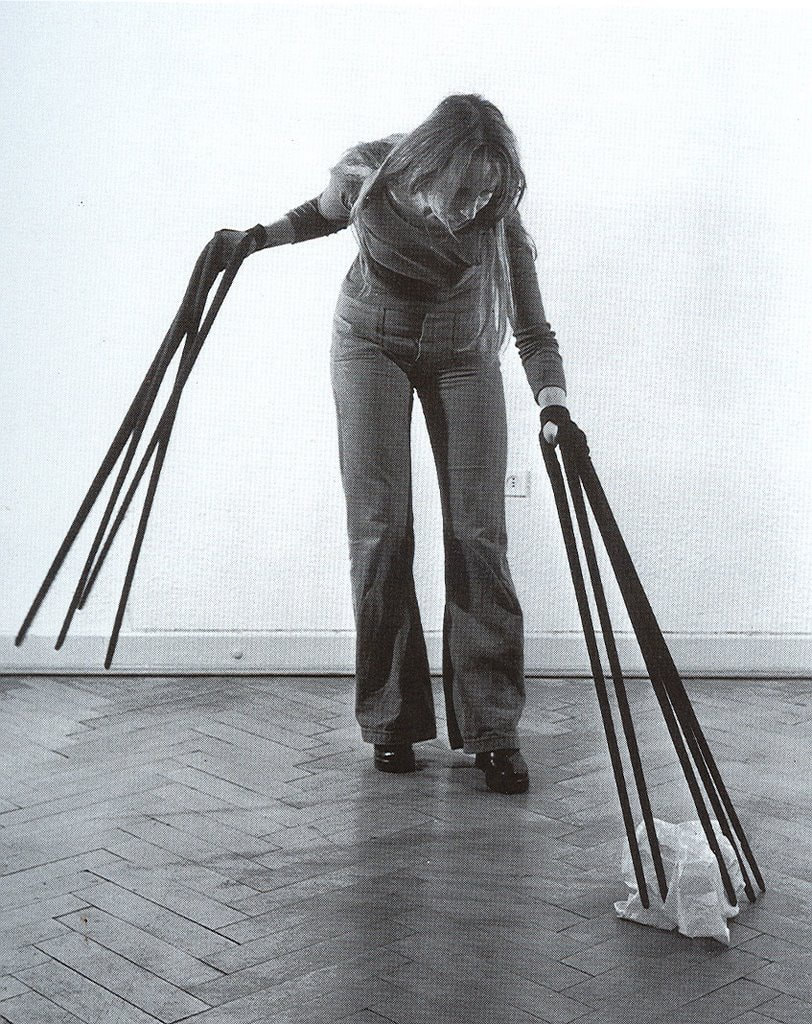BODY EXTENSIONS
Students should note that this is a sample assignment. Instructors may alter its contents, and referring to the materials given directly by the instructor will always be the most accurate.
OBJECTIVES
- The consideration of how we use our bodies and/or how we transport the viewer or ourselves.
- Material exploration (i.e. using cardboard, fabrics, wire etc.) And turning those planes or lines into forms with mass or volume.
- Surface treatment, including texture, invented texture, implied texture, and surface treatment. Painting or otherwise.
- Performance/Documentation
THE ASSIGNMENT
– Review the material for the Foundations theme of the semester The Body. The resources will help guide the conceptual elements of your work for the project and could spark ideas.
– Create and plan a design - this will help you think critically about construction and the steps needed to create volume and structure.
– Prep your materials - You will learn how to use utility knives, exacto blades, straight edge cutting, measuring, and using self-healing cutting boards, sewing, working with wire, using pliers, etc.
– Build your design using cardboard, wire, and if desired, hot glue. - This will count as a directed material exploration. You will learn general construction of elements using, glue, wire, tape, and perhaps sewing.
– Create a surface treatment - you may use hot glue, string, yarn, found materials, or elements of cardboard/wire to create texture. And you may choose to paint to leave the cardboard exposed. This will allow you to experiment with the creation of texture and to further your knowledge of color theory.
– Consider how your sculpture is presented - Will you preform, photograph with the intention of creating an implied narrative, pose on a neutral background wearing your sculpture, dramatize your documentation, or create video documentation? This will help you to understand CONTEXT, CONCEPT, and FUNCTION within your sculpture.
You must be able to discuss your color and textural choices, and at least 2 other formal elements in the work you create.
That is a total of 4 elements/principals.
– Review the material for the Foundations theme of the semester The Body. The resources will help guide the conceptual elements of your work for the project and could spark ideas.
– Create and plan a design - this will help you think critically about construction and the steps needed to create volume and structure.
– Prep your materials - You will learn how to use utility knives, exacto blades, straight edge cutting, measuring, and using self-healing cutting boards, sewing, working with wire, using pliers, etc.
– Build your design using cardboard, wire, and if desired, hot glue. - This will count as a directed material exploration. You will learn general construction of elements using, glue, wire, tape, and perhaps sewing.
– Create a surface treatment - you may use hot glue, string, yarn, found materials, or elements of cardboard/wire to create texture. And you may choose to paint to leave the cardboard exposed. This will allow you to experiment with the creation of texture and to further your knowledge of color theory.
– Consider how your sculpture is presented - Will you preform, photograph with the intention of creating an implied narrative, pose on a neutral background wearing your sculpture, dramatize your documentation, or create video documentation? This will help you to understand CONTEXT, CONCEPT, and FUNCTION within your sculpture.
You must be able to discuss your color and textural choices, and at least 2 other formal elements in the work you create.
That is a total of 4 elements/principals.
- Will your design be Representational, Nonrepresentational, or abstract?
- Planes - Are you using planes to create volumetric rectilinear forms, geometric forms, curvilinear lines, or organic shapes?
- What is the orientation of your design?
- Are you creating movement utilizing diagonals or patterns to create rhythm? Are you using visual weight to create balance or emphasis?
- How are you utilizing Space?
- How are you creating texture? What methods or materials have you decided to use to create texture?
- Will your work feature the use of geometric shapes? Will there be an implied shape? Will you create volume through the repetition of your lines? Will the form you create be a filled/solid shape?
- The point that is the focus of your composition or the secondary focus.
- Will you use One Point Perspective? Asymmetry? The rule of thirds (Vertical or Horizontal or both)? Radial symmetry?
- How about your use of color?
VOCABULARY
- Emphasis
- Focal Point
- Visual Balance
- Lift
- Repetition
- Tension
- Variety
- Asymmetry
MATERIALS
Cardboard, White Glue, Hot Glue, Drafting Tape, Xacto Knife, Cutting Board, Ruler, 45-Degree Triangle, Protractor, 220 grit Sandpaper
Cardboard, White Glue, Hot Glue, Drafting Tape, Xacto Knife, Cutting Board, Ruler, 45-Degree Triangle, Protractor, 220 grit Sandpaper
The content and writing for this project were provided by Brooke Day.


